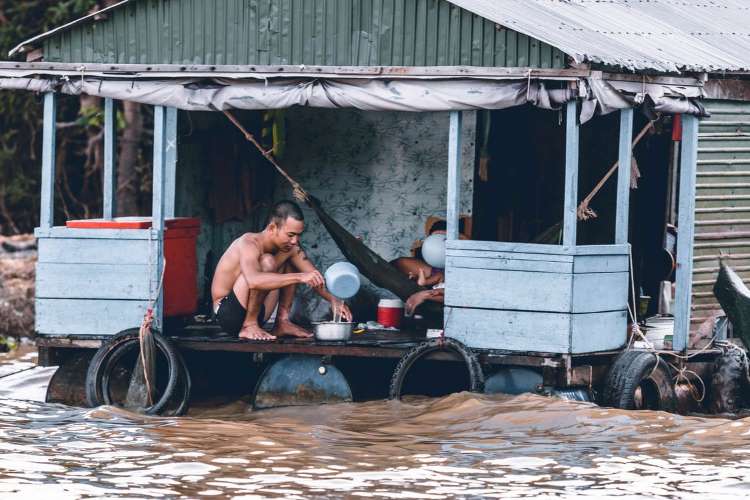
Climate change and associated extreme weather events have taken a devastating turn, as exemplified by the July 2023 floods that submerged several North Indian states including Uttarakhand, Himachal Pradesh, Uttar Pradesh, Jammu and Kashmir, Punjab, and New Delhi. Additionally, Gujarat, Andhra Pradesh, and Telangana in the Southern regions are grappling with torrential rains leading to flash floods and landslides. While flooding has been a recurring event in states like Assam and Bihar over the past years, the Northern Indian states are now facing an unprecedented disaster.
Absence of swift action from relevant authorities has exacerbated the situation. In India, approximately 40 million hectares are flood-prone out of a total land area of 329 million hectares. The primary sources of flooding remain incessant heavy rainfall and the release of water from dams.
READ I India’s sustainability quest: From desirable goals towards achievable ones
Economic ramifications of flooding
Floods bring about significant economic costs. The World Bank‘s estimations indicate that India annually incurs losses of $9.8 billion (approximately Rs 81,200 crore) due to extreme events, with floods accounting for 50% of these damages. Recent studies suggest that events like floods lead to a loss of around 0.46% of India’s GDP. In 2022, the country experienced 214 days of heavy rains, floods, and landslides. Reports from the State Bank of India (SBI) indicate that the economic losses due to floods in India in 2023 alone amount to around Rs 15,000 crore.
The National Disaster Management Authority (NDMA) estimates an annual loss of 1600 lives due to floods. In 2023, the floods in Northern India alone have caused at least 400 deaths, with the actual figure potentially higher. Beyond the tragic loss of human life, floods also result in substantial economic costs, including reduced labor productivity, workforce reduction, and decreased demand for products and services that are normally sought after. Additionally, livestock is adversely affected, leading to economic hardships for families reliant on these animals.
The flood crisis has suspended the livelihoods of people engaged in agro-based activities indefinitely. Ministry of Agriculture data reveals that between 2015-16 and 2021-22, over 339 lakh hectares were lost due to hydrometeorological disasters. Agricultural lands suffer from fertility loss due to soil erosion and sedimentation. Punjab, Haryana, and Uttar Pradesh—the prominent agricultural states—contribute 20 percent to India’s rice production. However, paddy farmers in Punjab and Haryana are grappling with the submergence of around 250,000 hectares and 150,000 hectares, respectively.
Furthermore, floods wreak havoc on infrastructure, including roads, bridges, embankments, and railways. In Himachal Pradesh, over 1000 roads were blocked due to power lines down and damaged infrastructure, stranding tourists. The economic toll expands as revenue generation from tourism and pilgrimage sites decreases, affecting the tourism sector. The industrial domain also experiences temporary shutdowns. The long-term consequences, including environmental degradation, harm to local ecosystems, loss of biodiversity, and soil erosion, incur substantial economic and financial losses.
Urban migration increases as people seek refuge from flood-affected areas, amplifying urbanisation costs and displacement issues. This leads to a demand for new settlements, straining government resources and exacerbating economic and social challenges. Urban areas are susceptible to floods, and poor urban planning compounds the plight of the people. Rapid and unplanned urbanisation contributes to impervious concrete surfaces that prevent rainwater from seeping into the ground, causing flash floods and groundwater depletion. Ironically, despite the presence of water, drinking water becomes scarce due to contamination risks post-flooding.
Floods bring about substantial opportunity costs—reflected in the value of what is sacrificed when making a choice. In the context of floods, these damages demand resources, time, and labor for reconstruction that could have been allocated to development projects. Relief efforts by state and central governments divert funds from potential development initiatives.
Businesses divert resources and efforts to flood recovery, hampering productivity and economic growth. Repairing infrastructure, compensating affected businesses, and assisting displaced residents drain funds from other developmental projects. This financial burden postpones critical investments, obstructing long-term economic progress and hindering daily routines, necessitating time-consuming recovery efforts.
Climate change mitigation
Effective policies are essential to address these challenges. Robust planning, rainfall pattern assessment, strong embankments, drainage system management in urban areas, and flood zoning are crucial measures. AI and smart flood warning systems equipped with sensors and remote monitoring can predict and issue early flood warnings, enabling preparedness and evacuation planning. AI can also rapidly and accurately assess damages, optimising flood relief allocation.
Traditional rainwater harvesting methods at individual or community levels can recharge groundwater aquifers, easing pressure on stormwater drainage during heavy rainfall periods. Integrating green infrastructure in urban planning, including green roofs, vertical gardens, and permeable pavements, aids in preserving urban wetlands that act as natural sponges. Flood-resistant building designs, flood-responsive transport infrastructure, and climate-resilient crop varieties, although time-consuming to implement, hold promise for long-term benefits.
Ultimately, collaboration among governments, the private sector, non-profit organisations, media, and various stakeholders is crucial. Increased accessibility to technology such as mobile apps for flood preparedness is imperative.
Public-private partnerships can pool resources, expertise, and innovation for infrastructure development, flood management, risk assessment, community engagement, and efficient resource allocation. While it is impossible to fully conquer the forces of nature, sustained attention, care, and concern from responsible authorities can alleviate the burden on our people, sparing them from graver and more severe hardships in the coming years.
(Kalita is an MA Economics student at the University of Hyderabad; Chakraborty is faculty in Economics at the Indian Institute of Management Visakhapatnam; and Thakur is faculty in Economics at FLAME University, Pune. Views expressed are personal.)
